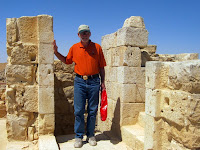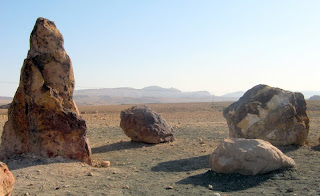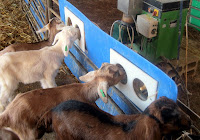As readers of this blog know, Dan and I spent a glorious month in Israel thanks to his winning us tickets from the
American Friends of Ben Gurion University of the Negev. After days in Tel Aviv, Beersheva (getting to visit the
Ben Gurion University of the Negev campus & research facility), and then our stay at the Dead Sea, and exploration of Masada, our next two days were a grand, "foodie-winey" adventure in the Negev Desert, but before we left the Dead Sea, I HAD to have one more "dip and float" in the morning! Then Dan and I had our "tourist photo" on the Big Blue Bull in front of the
Crowne Plaza Dead Sea, and breakfast at the Ein Bokek McDonald's, just to say we did!
 |
| View of the Dead Sea from our Crowne Plaza room... |
 |
| D & E on the Big Blue Bull... |
 |
| Yes, you can do Mickey D's at the Dead Sea! |
 |
Archaeological sites in the Negev...
|
 |
| CrocoLoco! |
Driving thru the Negev, we found a truly unique place:
The CrocoLoco Crocodile Farm at Ein Hatzeva Junction!
CrocoLoco is a unique desert farm raising the African Nile crocodiles that were once indigenous to the area, and helping protect the species from extinction by providing buyers in the leather industry with a sustainable alternative to skins acquired through illegal hunting. We not only got to learn about them, Elisse got to play "pat-the-croco"!
 |
| CrocoLoco! |
 |
| CrocoLoco! |
 |
| Up close & personal! |
 |
| Elisse, making nice-nice with a baby crocodile! |
 |
| At an archaeological site in the Negev |
 |
| Train crossing in the desert... |
 |
| The Negev... |
 |
| Petrified Forest in the Negev |
 |
| Petrified Forest |
Heading for
Naot Farm, a gourmet goat cheese farm in the Negev, we stopped along the way at the archaeological digs we passed, and to see the ancient
Petrified Forest. Seeking uniquely Israeli things to do and places to stay, so that Dan (as well as I) could experience as much "real" Israel as possible and meet some great people, I arranged for us to spend a night at
Naot Farm, run by the charming and welcoming Nachimov family, where we got to pet the baby goats, see how their gourmet goat cheeses are made, stay in lovely Cabin 1 (you can see it on their website!), and enjoy a truly splendid breakfast that included a selection of their delicious goats milk cheeses and milk, as well as freshly baked breads, salads & spreads, honey (from a local Negev farm, which we bought), eggs, and fresh-squeezed orange juice! (I loved the handmade soaps in our guest room!) We bought food & Israeli wine at the nearby gas station store (LOL - if only US gas stations sold fine wine & made cappuchino!), and made ourselves a pasta dinner that night in our romantic little cabin, sitting outside on our desert porch with our wine, enjoying the cool desert night and a sky sprinkled with a billion stars...
 |
| Milking goats at Naot Farm |
 |
| Dan & Elisse, petting goats at Naot Farm! |
 |
| L'Chiam! |
 |
| A desert night... |
 |
| Chef Dan, making dinner in the desert! |
 |
| A cappuccino & gourmet goat milk for breakfast! |
 |
| Totally scrumptious breakfast, delivered to our cabin...goat cheeses, fresh OJ, breads, & salads... |
 |
| Baby goats! |
 |
| Tiny kids, all snuggled up! |
 |
| Gourmet goat cheese... |
 |
| Making cheeses by hand... |
 |
| Our cabin in the desert... |

I booked us stays at both this lovely, rustic farm bed-and-breakfast, and the
Carmey Avdat Winery, where we spent the next night, so we got to experience a bit of the "off the beaten path" Israel I love so much. Once-upon-a-time (not so long ago!) Israel was "famous" for having one or two truly mediocre wines that were tooth-rottingly sweet- not any more!
Israel now has more than 300 wineries producing internationally-acclaimed, award-winning wines, some selling for upwards of $300 a bottle, and wineries literally crisscross the country from the Negev desert to the snow-capped mountains of the Golan Heights! In a tiny country the size of New Jersey this is nothing short of amazing! The best part is that Israeli restaurants and bars feature and promote Israeli wines, so although Dan and I only had a chance to visit a few wineries throughout our month in Israel, we enjoyed a wide variety of Israeli wines throughout our stay. We tasted and bought wine at each winery we visited, and were able to bring at least one bottle of wine from each back to the Elkhorn Inn to share and enjoy with friends! (And Elisse knows how to pack a suitcase! LOL)
On the way to Carmey Avdat, for example, we stopped at the
Rota Winery, in the Negev Heights, which was suggested to us by Ben Brewer of
Israel Food Tours , and we weren't disappointed! To stand out in the middle of a desert vineyard in the warmth of a spring morning, tasting a selection of fine wines with Erez Rota, the winemaker, surrounded by his sculptures, was one of The most delightful experiences we had on this trip!
 |
| Erez Rota & Dan, in the vineyards... |
 |
| Desert sculpture by Erez Rota |
 |
| Erez Rota, creating a desert wine-tasting... |
 |
| A wine tasting in the desert at Rota Winery |
We bought several Rota wines, including his excellent 2008 Cabernet Sauvignon. A boutique winery, Rota is now producing more than 10,000 bottles a year, for export as well as domestic consumption, they are now certified Kosher, and his wines are, deservedly, doing well in international competitions!
Following the little "grape" signs along the highways, our next stop on the
Negev Wine Route was the
Nahal Boker Winery, where we ran into friends from
Ben Gurion University of the Negev, who were showing Israel's wineries off to a bevy of journalists! We enjoyed a wine tasting with Moshe Zohar, who founded the winery together with his wife Hilda, and bought a bottle of his wine, as well as local olive oil, in the lovely shop/dining room that overlooks a Negev vista "what to die for"!
 |
| Moshe Zohar, founder of Nahal Boker Winery |
 |
| Nahal Boker vineyards |
 |
| Sculpture in the Negev mountains... |
We arrived at our destination
, Carmey Avdat Vineyards, in the late afternoon. Founded by Hanna and Eyal Izrael in the Negev Highlands, Carmey Avdat is a small, family-run winery producing approximately 6000 bottles of wine a year, based on Merlot and Cabernet Sauvignon, and uniquely located on the terraces of a 1500-year old agricultural settlement on the ancient Spice Route! The vineyard is irrigated with water from the flash-floods that occur each winter in the Negev mountains, and the cold winters and dry summers have provided an ideal climate for growing wine grapes since ancient times. We had a lovely, romantic cabin, and a delicious dinner of veal with mushrooms, Vietnam-style spring rolls, zucchini with mint, fresh lemonade, and sweets was delivered to our door! We enjoyed it, together with a bottle of Israeli wine, on the little outdoor table overlooking their beautifully landscaped farm, and had a totally perfect evening! In the morning, after our delivered-to-the-door gourmet breakfast, we got to see the Izraels bottling their Port wine, and then had a wine-tasting with Eyal Izrael of their various vintages, buying bottles of our faves: their
2007 Merlot and Cabernet Sauvignon, and their truly fine
Port, to take with us!
(From Wines Israel: Carmey Avdat, Merlot, 2007: Dark garnet with a hint of adobe, medium- to full-bodied with good concentration and extraction, its tannins and spicy wood now integrated, opens to show appealing blackberry, black cherry, purple plums and chocolate, all lingering nicely on the palate. Drink now. Score 87. Carmey Avdat, Cabernet Sauvignon, 2007: Dark garnet, medium- to full-bodied, with soft tannins and notes of spicy wood. On the nose and palate blackcurrant, blackberry and cherry fruits, those on a background of earthy minerals and a hint of mint on the finish. Drink now. Score 85).
 |
| Carmey Avdat Vineyards |
 |
| Dan, in front of our cabin at Carmey Avdat |
 |
| Dan & Eyal Izrael, at our wine tasting |
 |
| Port, being bottled |
 |
| Dan, at Carmey Avdat |
 |
| Spring! |
 |
| Elisse, in our cabin's hammock! |
 |
| Elisse, in the ancient/modern Carmey Avdat vineyards |
Next: Drinking Israeli wine in a 2000 year old wine press, & Israel's answer to the Grand Canyon!

















































































